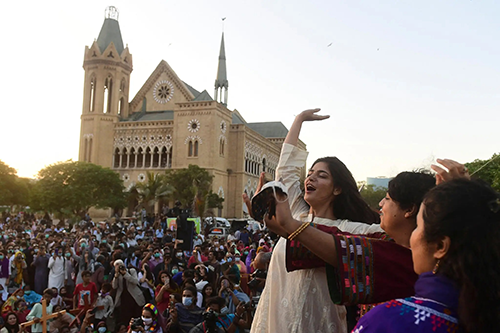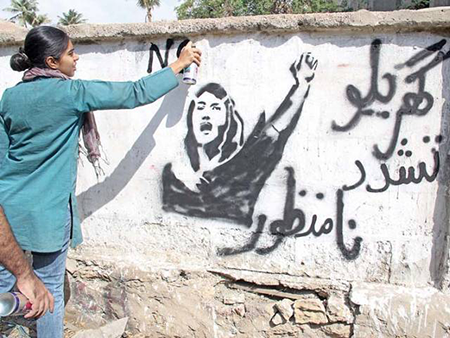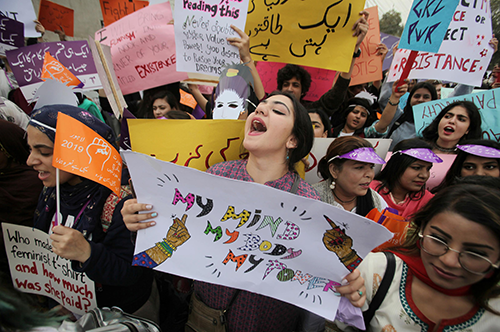How many times have we heard this assertion, by now almost a cliché: “meri beevi kaam naheen karti” (my wife doesn’t work), stated with male superiority complex, egotism and patriarchal arrogance – often accompanied by the twirling of a real or imaginary mustache tip? Answer: one time too many … sigh … yawn.
Way back, around three decades ago, Nigar Ahmad and Advocate Shahla Zia, co-founders of Aurat Foundation, produced a startling poster bearing the same title “meri beevi kaam naheen karti” – and then proceeded to graphically illustrate and enumerate the myriad items of work that women do, comprising productive, reproductive and domestic labour.
It was a long list, but almost all of it comprised unwaged, unpaid, unremunerated hard labour. Sadly, women’s work still remains mostly unrecognised, unappreciated, uncounted and unvalued.
Women’s work is not just denied by their spouses, fathers, brothers, sons, along with extended natal and marital family members – but shockingly, also by successive civilian and military dispensations over the past 75 years. Thus, both poverty and hunger, silently but inherently, have a Woman’s Face in Pakistan.
Two decades ago, a federal minister courageously acknowledged this publicly, at an international forum – even asserting that the male-female poverty ratio stood at 1:3; i.e. 3 out of 4, or 75% of the poor in Pakistan, are women. To date, no one has refuted this.
However, left-leaning and progressive rights activists, economists and analysts might counter with the assertion that poverty as a whole is increasing rapidly today – unfortunately coinciding with Pakistan’s 75th anniversary – thus, why focus on women?

True, it is no longer news that inflation in Pakistan (and globally) is at an all-time high, with skyrocketing food, fuel and energy costs now also hitting – and badly hurting – our slim middle class, in addition to hurtling more and more millions of our compatriots into abject poverty. Our internationally respected guru, Dr Hafiz Pasha actually predicted an exponential rise in Pakistan poverty before and during the height of the Covid-19 pandemic, and beyond. He was right, of course. We are seeing it play out now.
But those then in power chose to ignore Dr Pasha’s (and others of his ilk) doable and necessary prescriptions, both short- and long-term measures repeatedly detailed in his recent fascinating comprehensive economic reform agenda work: Growth and Inequality in Pakistan: Agenda for Reform and Charter of the Economy – which, if heeded, might have been able to save the economy (and the rupee too) from the freefall we are now witnessing, or the possible default staring us in the face.
Successive Pakistani governments push the blame for economic mismanagement on to their predecessors – and then proceed to commit the same, if not worse, blunders themselves, in a classic catch-22 downward spiral. But this is a sore subject, better left for an in-depth discussion another time.
It is worth taking the time to read Oxfam’s 2022 report on global poverty, titled “First Crisis, Then Catastrophe”. It estimates, inter alia, that 263 million more people could be pushed into extreme poverty in 2022, due to the combined impact of Covid-19, inequality, poverty, and food plus energy price inflation (excluding climate change impact). A sobering eye-opener, it ought to be required reading for those in power in all three pillars of our state (as well as those operating behind the scenes) – and also for the few sane elements in our fourth estate.
Over the past two decades since that former federal minister’s startling announcement, no macro-level research study or survey on the quantum of feminisation of poverty has been commissioned, either by the federal and provincial governments, or by the external donor/creditor agencies, who fund our governments, NGOs, research entities, academia, and so on
One recalls that in December 2021, Dr Pasha had forecast an additional 6 to 8 million Pakistanis imminently falling into poverty, based on then-current macroeconomic trends. After the cataclysmic impact of the fiscal and economic policy measures the incoming coalition government was forced to take between April and July 2022 – mainly to meet the IMF’s stringent conditionalities – he and his team might well be crunching out new numbers now – presumably topping 10 million, given the visibly increasing throngs of beggars and charity-seekers, mostly women and children.
This does not include large swathes of the urban blue collar working class sliding down to the “nouveau-poor” category, or those in the lower middle class who are unable to beg or borrow – and would not dream of stealing or accepting charity – but are now in desperate straits, unable to make ends meet.
One wonders who – if anyone – is looking out for the rural poor or the poverty-stricken urban katchi abaadi-jhuggi dwellers – the downtrodden – the unemployed – the unemployable – the barely subsisting awaam, who are now finding it difficult to eat even one square meal per day, with rotti going up imminently from Rs15 to Rs20 at urban tandoors, especially in Pakhtunkhwa cities. For a family of 7, that comes to Rs140 per meal for bread alone, and times two meals, it amounts to Rs280 per day, coming to a whopping Rs8,400 per month. It is needless to point out that minimum wages have not kept up with galloping food inflation, energy and fuel price hikes or devaluation.
Important note: “minimum wage” is not the ILO definition of a “decent living wage”.
Along roadsides in the big cities, when one sees long queues of men waiting to receive (or sitting there and eating) a free meal in charity from philanthropists, one wonders what the women, children and elders of their households are eating at home, if anything.
That brings us back unapologetically to women in poverty. Over the past two decades since that former federal minister’s startling announcement, no macro-level research study or survey on the quantum of feminisation of poverty has been commissioned, either by the federal and provincial governments, or by the external donor/creditor agencies, who fund our governments, NGOs, research entities, academia, and so on.
Nevertheless, Dr Pasha and his team have been computing the Multidimensional Poverty Index (MPI) too. Earlier, Dr Mahbubul Haq conceptualised and tabulated our Poverty of Opportunity Index (POPI) at around 40% (1990s). Unsurprisingly, for compiling its poverty reports, the World Bank uses government data, based on the PSLM and HIES, from the Pakistan Bureau of Statistics (PBS). The previous government asserted that overall poverty stood at 22% in 2021, whereas independent researchers agree that it was much higher then and is significantly higher in 2022.
Over the past two decades no macro-level research study or survey on the quantum of feminisation of poverty has been commissioned, either by the federal and provincial governments, or by the external donor/creditor agencies, who fund our governments, NGOs, research entities, academia, and so on
To quote a 2016 UNDP-funded study on MPI, also using PSLM data:
“…multidimensional poverty “headcount ratio” was estimated at 38.8% of the population. This means that 38.8% of the population of Pakistan are poor according to the MPI. The average intensity of deprivation, which reflects the share of deprivation which each poor person experiences on average, is 50.9%.”
However, while pointing out stark urban-rural and provincial disparities, UNDP omitted mentioning gender inequality in poverty, hunger and MPI data.
Based on the government’s UN-supported national nutrition survey (2018), Pakistan has a high level of food insecurity (37%), with chronic hunger at over 18.3%; moderate under-nutrition (7.6%); mild (11.1%). This data needs to be sex-disaggregated too.
In its 3rd quarterly report FY2019, the State Bank of Pakistan (SBP) noted that we rank 106th among 119 countries on the Global Hunger Index: “…characterised as facing a ‘serious’ level of hunger”. The SBP called it a ‘dismal’ state of affairs, caused mainly by poverty and inequality, not a shortage of food stocks in the country.

It is important to recall the outcome of that cringe-worthy debate and debacle on basic poverty data computation in FY2005-06 between the Ministries of Finance & Economic Affairs and Planning & Development under the military dictator, General Pervaiz Musharraf and his imported PM Shaukat Aziz. Kudos to then-Chief Economist, Dr Pervez Tahir, for his courageous, principled stand – albeit at high professional cost.
The subsequent outcome was that the annual Pakistan Economic Survey (PES) of the federal Ministry of Finance “resolved” the problem by simply omitting the poverty chapter. An indirect, cursory discussion on social safety nets in a chapter titled “Social Protection” is clearly not a substitute for poverty and cannot fill the glaring void.
Hence, there remains a lack of credible official data and analysis on poverty in Pakistan, leave alone what successive governments ought to be doing to eradicate it. Researchers thus rely either on independent analysts, or international data sources, or inaccurate PBS official statistics, but “The PBS has in recent months engaged in presenting biased statistics” (Dr Hafiz Pasha, Business Recorder, 6 May 2022).
Without accurate or credible baseline data for planning, policymaking and budgeting, it is unclear how Pakistan can ever hope to achieve any of the Sustainable Development Goals (SDGs), especially Goal #1: Poverty Eradication and Goal #5: Gender Equality and Women’s Empowerment. In an ideal world, both would be addressed together.
The Benazir Income Support Programme (BISP) – which the ousted PTI government politically renamed as its “Ehsaas” programme – was never intended to be a poverty reduction (leave alone eradication) programme, as it was simply a temporary, miniscule social safety net for the ultra-poor. However, successive governments have proudly – albeit erroneously – showcased it as their flagship initiative against poverty. Despite quantitative, geographic and budgetary expansion over the past 12 years, it still remains just a small drop of minor relief in a huge ocean of deprivation and need.
In fact, the BISP is seen to foster long-term dependency instead of self-reliance and resilience. Unfortunately, it has allegedly also been perceived as an election vote-gathering ploy, especially its unconditional cash transfer (UCT) component. Conditional cash transfers (CCTs) – e.g. those linked to girls’ education – are somewhat better conceptualized.
On the positive side, by focusing on women, the BISP has monetarily incentivised patriarchal male family heads to consent to obtain CNICs for women. This also serves the objective of increasing women’s voter registration and obtaining other ID legal documentation.
Pakistan signed on to the UN’s Millennium Development Goals (MDGs) in 2000 and the Sustainable Development Goals (SDGs) in 2015. Having failed spectacularly in all the MDGs, it remains to be seen whether or not any of the 17 SDGs can be achieved by 2030. Currently, the signs are not hope-inducing.
Despite the 2010 Constitutional Amendment, Article 25-A – Right to Education – and ensuing provincial legislation; and despite girls’ increasing school enrolment in urban areas; there is continuing stark gender disparity in access to education and vocational skills training, especially in rural, remote, marginalised communities – thereby perpetuating the feminisation of poverty across generations. Of the estimated 23 million children out of school, the vast majority are girls.

Women’s lack of assets ownership renders them ineligible for formal credit – so they remain locked into underpaid, unpaid, bonded, or slave labour – or beggary, sexual trafficking and prostitution.
There is no dearth of analysis of these challenges over the past four decades. Since we know what the problems are, thus such self-serving euphemisms and classic delaying bureaucratese jargon as: “need for comprehensive vulnerability assessment for achieving gender-responsive social protection” are ludicrous. Neither is required at this juncture. Urgently needed is implementation of the recommendations below.
The way forward
It is high time, and beyond, for our leaders and policymakers to stop perceiving poverty as a temporary, minor aberration, to be “alleviated” or “reduced” in the charity and welfare mode, rather than as a huge challenge for human dignity, empowerment, and environmentally sustainable economic development – requiring complete poverty eradication, as per our Constitutional provisions.
There is nothing new about the varied prescriptions below. What would be astonishingly new and refreshing would be their endorsement by any political leadership, followed by actual implementation.
Data: correction of macroeconomic data and labour statistics, e.g. changing the definition and methodology of calculating the GDP, labour force, and other statistics to count and quantify women’s sizeable economic contribution – their currently invisible work and productivity in unpaid, underpaid, or informal labour.
Ensuring accurate annual collection, compilation, presentation of sex-disaggregated data in official poverty and employment statistics (e.g. PES, LFS-LFPR, MPI).
Immediately reinstating the poverty chapter in the annual PES, along with reporting on the SDGs.
Legislation is urgently required to eliminate women’s economic exploitation; non-recognition or devaluation of women’s productivity; revised definition of work for inclusion of: rural agricultural women, urban domestic and home-based workers (HBWs); informal, contractual, piece-rate workers in the formal organised labour force; legal recognition and formal registration of de facto women-headed households (WHHs).
Likewise, registration of all women workers as formal labour force, especially rural agricultural women, urban home-based workers (HBWs), domestic workers/maids, industrial contract labour, and ex-bonded slave labour, will ensure women’s access to the benefits of social security (ESSIs); workers welfare funds (WWF); pension (EOBI); free reproductive health services (RSHR); children’s education (RTE); vocational skills training; OSH training and protective equipment; life and disability insurance; gender-responsive budgeting (GRB) and credit; legal ID documentation; and the right to unionize (via TUs, CBAs and cooperatives).
Assets: required measures include: ensuring women’s personal ownership of assets and credit-worthiness, including joint land and property title ownership; ensuring implementation of women’s legal right to inheritance; 50% ownership of marital moveable and immoveable assets; granting title deeds to minimum one acre of cultivable state land to each woman landless peasant-farmer in her own name.
Credit: to address visibly increasing socio-economic gender inequality, there is a need for facilitation of women’s access to easy, cheap credit, without impractical collateral requirements.
For low-income (or no-income) women’s entrepreneurship and self-employment, there is an urgent need to reactivate and revitalize the First Women’s Bank (FWBL), recognising its intended purpose, mandate, and value as an affirmative action entity focusing on women in poverty – not to be privatised for puny short-term gains.
There are also other successful commendable women-focused financial models for the state to replicate, e.g. inter alia, Kashf Foundation, AKRSP, RSPN, village cooperatives, group guarantees.
Recognising chronic gender injustice, structural inequality, and an uneven playing field, concrete Affirmative Action is required to decrease the feminisation of poverty and hunger by ensuring implementation of women’s public sector job quotas, paid maternity-paternity leave, child care services, hostels, transport; also, most importantly, professional, market-focused job-creation programmes; women’s vocational, technical skills training, along with career development paths – in order to break that invisible but real glass ceiling that women face.
Women’s lack of assets ownership renders them ineligible for formal credit – so they remain locked into underpaid, unpaid, bonded, or slave labour – or beggary, sexual trafficking and prostitution
Correcting the definition of “poverty reduction” requires acknowledging that the BISP is a tiny social safety net for temporary social protection – not the required vast “poverty reduction programme”, as discussed above.
There is a need to incentivise poverty eradication in the longer term, via increased, strengthened conditional cash transfers (CCTs), especially girls’ professional education and skills training, particularly in the STEM sectors; along with a corresponding increase in sustainable, climate change-focused job creation, with public-private partnership.
Implementation of gender equality measures requires compliance with ILO-ratified Conventions 100 and 111; also the urgent ratification of ILO Conventions 177 and 189; along with initiating Gender Responsive Budgeting (GRB) across the board.
Lastly – most importantly and imperatively – urgent measures are required to reduce the currently unsustainable 2.4% annual population growth rate, which negates all other steps to improve economic growth and eradicate poverty and hunger.
In the 75th year of our Independence, as a nuclear power of around 230 million citizens, the state of Pakistan can no longer afford to ignore the twin elephants in the room – runaway population growth, plus burgeoning poverty, social injustice and inequality, especially women in poverty, hunger and destitution.
While equality of outcome for human endeavour cannot be guaranteed, equality of opportunity is a prerequisite. It is practically doable and morally imperative. Our policy, law and decision-makers need to wake up before it gets too late.



